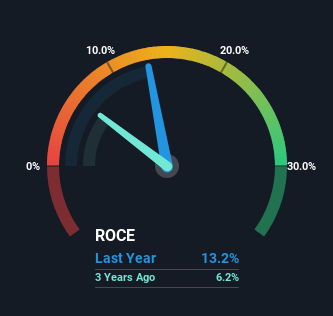Investors Met With Slowing Returns on Capital At Wärtsilä Oyj Abp (HEL:WRT1V)

Finding a business that has the potential to grow substantially is not easy, but it is possible if we look at a few key financial metrics. In a perfect world, we'd like to see a company investing more capital into its business and ideally the returns earned from that capital are also increasing. Ultimately, this demonstrates that it's a business that is reinvesting profits at increasing rates of return. In light of that, when we looked at Wärtsilä Oyj Abp (HEL:WRT1V) and its ROCE trend, we weren't exactly thrilled.
What Is Return On Capital Employed (ROCE)?
If you haven't worked with ROCE before, it measures the 'return' (pre-tax profit) a company generates from capital employed in its business. To calculate this metric for Wärtsilä Oyj Abp, this is the formula:
Return on Capital Employed = Earnings Before Interest and Tax (EBIT) ÷ (Total Assets - Current Liabilities)
0.13 = €425m ÷ (€6.9b - €3.7b) (Based on the trailing twelve months to March 2024).
So, Wärtsilä Oyj Abp has an ROCE of 13%. In absolute terms, that's a pretty normal return, and it's somewhat close to the Machinery industry average of 12%.
See our latest analysis for Wärtsilä Oyj Abp

Above you can see how the current ROCE for Wärtsilä Oyj Abp compares to its prior returns on capital, but there's only so much you can tell from the past. If you're interested, you can view the analysts predictions in our free analyst report for Wärtsilä Oyj Abp .
So How Is Wärtsilä Oyj Abp's ROCE Trending?
There hasn't been much to report for Wärtsilä Oyj Abp's returns and its level of capital employed because both metrics have been steady for the past five years. It's not uncommon to see this when looking at a mature and stable business that isn't re-investing its earnings because it has likely passed that phase of the business cycle. So don't be surprised if Wärtsilä Oyj Abp doesn't end up being a multi-bagger in a few years time. This probably explains why Wärtsilä Oyj Abp is paying out 51% of its income to shareholders in the form of dividends. Unless businesses have highly compelling growth opportunities, they'll typically return some money to shareholders.
On another note, while the change in ROCE trend might not scream for attention, it's interesting that the current liabilities have actually gone up over the last five years. This is intriguing because if current liabilities hadn't increased to 54% of total assets, this reported ROCE would probably be less than13% because total capital employed would be higher.The 13% ROCE could be even lower if current liabilities weren't 54% of total assets, because the the formula would show a larger base of total capital employed. So with current liabilities at such high levels, this effectively means the likes of suppliers or short-term creditors are funding a meaningful part of the business, which in some instances can bring some risks.
Our Take On Wärtsilä Oyj Abp's ROCE
In a nutshell, Wärtsilä Oyj Abp has been trudging along with the same returns from the same amount of capital over the last five years. Since the stock has gained an impressive 70% over the last five years, investors must think there's better things to come. However, unless these underlying trends turn more positive, we wouldn't get our hopes up too high.
Wärtsilä Oyj Abp could be trading at an attractive price in other respects, so you might find our free intrinsic value estimation for WRT1V on our platform quite valuable.
While Wärtsilä Oyj Abp may not currently earn the highest returns, we've compiled a list of companies that currently earn more than 25% return on equity. Check out this free list here.
Valuation is complex, but we're here to simplify it.
Discover if Wärtsilä Oyj Abp might be undervalued or overvalued with our detailed analysis, featuring fair value estimates, potential risks, dividends, insider trades, and its financial condition.
Access Free AnalysisHave feedback on this article? Concerned about the content? Get in touch with us directly. Alternatively, email editorial-team (at) simplywallst.com.
This article by Simply Wall St is general in nature. We provide commentary based on historical data and analyst forecasts only using an unbiased methodology and our articles are not intended to be financial advice. It does not constitute a recommendation to buy or sell any stock, and does not take account of your objectives, or your financial situation. We aim to bring you long-term focused analysis driven by fundamental data. Note that our analysis may not factor in the latest price-sensitive company announcements or qualitative material. Simply Wall St has no position in any stocks mentioned.
Have feedback on this article? Concerned about the content? Get in touch with us directly. Alternatively, email editorial-team@simplywallst.com
About HLSE:WRT1V
Wärtsilä Oyj Abp
Offers technologies and lifecycle solutions for the marine and energy markets worldwide.
Flawless balance sheet with solid track record.

